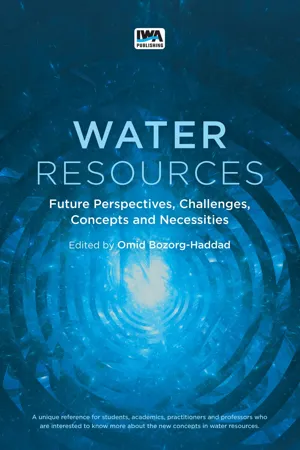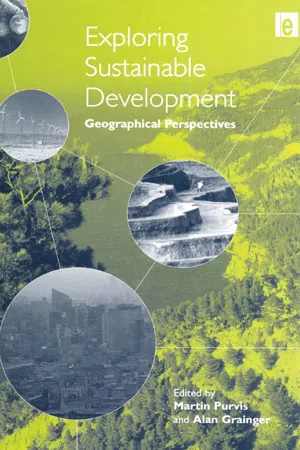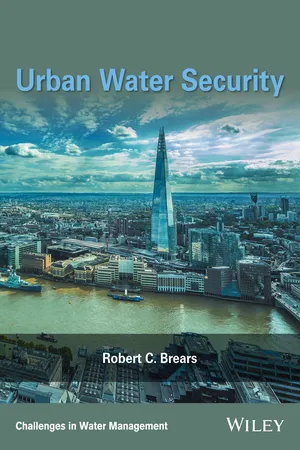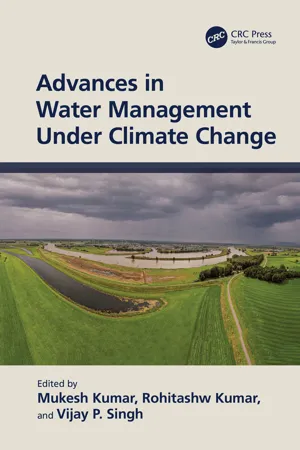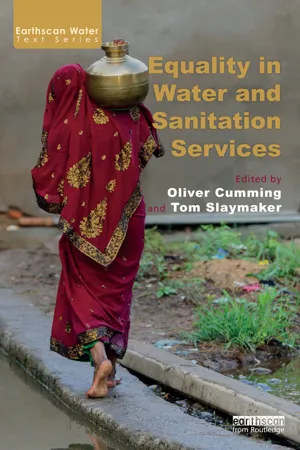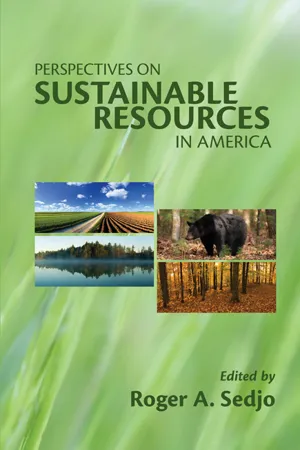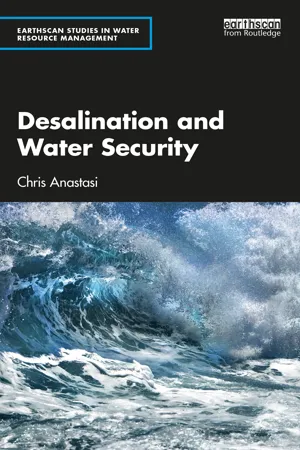Geography
Sustainable Water Supplies
Sustainable water supplies refer to the management and use of water resources in a way that meets current needs without compromising the ability of future generations to access clean and adequate water. This involves practices such as water conservation, efficient use of water, and the protection of water sources from pollution and depletion. Sustainable water supplies are essential for environmental and human well-being.
Written by Perlego with AI-assistance
Related key terms
10 Key excerpts on "Sustainable Water Supplies"
- Omid Borzog-Haddad(Author)
- 2021(Publication Date)
- IWA Publishing(Publisher)
Sustainability of water management in urban, agricultural and environmental contexts is essential for sustainable development. There are many ways to evaluate sustainable management practices. Integrating socio-economic characteristics of environmental systems should be quantified in order to represent and implement developments. Urban water management in developing regions faces challenges such as unequal distribution of water due to rapid population growth. Sustainable management plans should focus on issues such as attracting shareholders to invest in developing areas and revitalizing and reusing water in developed areas. Water reuse reduces the stresses caused by drought periods. However, there are still obstacles, including the cost of using these technologies and the risks involved in developing and developed countries alike. Improving water productivity in the agricultural sector is beneficial to all other sectors through the use of new irrigation technologies and methods, as it reduces competition between agricultural, urban and environmental sectors. Achieving water sustainability only in the environmental field could be inconsistent with other development plans, and occur as a result of a restricted and uncomprehensive approach. However, long-term economic development and social goals of societies are linked to both environmental health and environmental fracture, which is why developed countries emphasize socio-economic development. Sustainable water management can provide sustainability in all socioeconomic and environmental sectors in areas with diverse geographies.Sustainability indices (SIs) such as reliability, resiliency, and vulnerability are indices that determine the probability of successful water allocation, probability of a system returning to its desired state after a failure, and the magnitude of damage that system receives during failures, respectively. Various types of studies in the field of sustainable water resources management have been carried out and have unveiled the advantages of sustainable development management of these human-natural systems. Furthermore, sustainability in the field of water management can be applied to different types of water bodies; such as sustainable groundwater management, sustainable river basins, coastal basins, and to other kinds of water bodies. Current research has introduced a wide range of applications of sustainable water resources research, not only making systems more sustainable but also reducing vulnerabilities in the future.There are different ways to apply sustainability in water resources management. One practical way to model sustainable water management is a multi-criteria decision-making process that provides higher efficiency in water allocation. Another way is the risk reduction approach in water supply, environmental protection, and economic efficiency, which ensures long-term and flexible water supply in agricultural, municipal, and industrial sectors. In addition to reliability, resiliency and vulnerability, the Water Poverty Index (WPI) summarizes the information required to evaluate the sustainability of water systems and can be used as a singular measure to assist decision-makers in determining priorities and coming up with proper development plans.- eBook - ePub
The Water Footprint Assessment Manual
Setting the Global Standard
- Arjen Hoekstra, Ashok K. Chapagain, Maite M. Aldaya, Mesfin M. Mekonnen(Authors)
- 2012(Publication Date)
- Routledge(Publisher)
Environmental sustainability: Water quality should remain within certain limits. As an indicator of what these limits are, one can best consider ‘ambient water quality standards’ that people have agreed upon. In addition, river and groundwater flows should remain within certain limits compared to natural run-off, in order to maintain river and groundwater-dependent ecosystems and the livelihoods of the people that depend on those ecosystems. In the case of rivers, the so-called ‘environmental flow requirements’ form boundaries for run-off alteration, comparable to the way in which water quality standards form boundaries for pollution (Richter, 2010). In the case of green water, the ‘environmental green water requirements’ form the boundaries for green water appropriation for human purposes.- Social sustainability: A minimum amount of the freshwater available on Earth needs to be allocated to ‘basic human needs’, most notably a minimum domestic water supply for drinking, washing and cooking and a minimum allocation of water to food production to secure a sufficient level of food supply to all. This criterion implies that only the fraction of available freshwater supply that remains after subtraction of environmental water needs and water requirements to sustain basic human needs can be allocated to ‘luxury’ goods. A minimum domestic water supply for drinking, washing and cooking needs to be guaranteed at the catchment or river basin level. A minimum allocation of water to food production is to be secured at global level, since river basin communities are not necessarily self-sufficient in food, provided that food security is ensured through food imports.
- Economic sustainability: Water needs to be allocated and used in an economically efficient way. The benefits of a (green, blue or grey) water footprint that results from using water for a certain purpose should outweigh the full cost associated with this water footprint, including externalities, opportunity costs and a scarcity rent. If this is not the case, the water footprint is unsustainable.
When the green, blue or grey water footprint in a catchment does not fulfil one of the criteria of environmental, social or economic sustainability, the water footprint cannot be considered as ‘geographically sustainable’.After having identified hotspots, one can study the environmental, social and economic implications in more detail. We distinguish between identifying ‘primary’ and ‘secondary’ impacts. Primary impacts are described in terms of changed water flows and quality (compared to the natural conditions, without human disturbances). One will show, for example, how much run-off in a catchment has decreased by man's blue water footprint in the catchment and to which extent this conflicts with environmental flow requirements. Or one describes in detail how water quality has changed compared to natural conditions, for instance per water quality parameter, and which parameters violate the ambient water quality standards. Secondary impacts are the ecological, social and economic goods or services that are impaired in a catchment area as a result of the primary impacts. Secondary impacts can be measured for instance in terms of lost species, reduced biodiversity, reduced food security, affected human health, reduced income from water-dependent economic activities, and so on. - eBook - ePub
Exploring Sustainable Development
Geographical Perspectives
- Martin Purvis, Alan Grainger(Authors)
- 2013(Publication Date)
- Routledge(Publisher)
2
Geography and SustainableDevelopment
Martin Purvis
Introduction
The current state of the world has led many commentators to conclude that the unequal priority given to economic growth, social welfare and the health of the environment renders established development patterns unsustainable. The alternative ideal of sustainable development – that which ‘meets the needs of the present without compromising the ability of future generations to meet their own needs’ (WCED, 1987) – has, therefore attracted increasing support. But once we look beyond such broad definitions, much remains elusive and contested about sustainable development. As noted in Chapter 1 , the scope of existing economic theory is limited, and few others have taken up the challenge of establishing a sound theoretical foundation for future action. It is, of course, also true that the label of sustainable development is applied to an increasing number of practical measures. However, the sheer number and diversity of such initiatives, and the mixture of motives that inspire them, only adds to the ambiguity which surrounds the concept. There is still, therefore, much work to be done if sustainable development is to be established as a credible blueprint for the 21st century.The chapter begins by comparing geography’s long-standing interest in both society and nature, and the links that unite them, with the new agenda of sustainable development. This is followed by a brief review of the attention given to sustainable development in the geographical literature, and to the themes of place and space in discussions of sustainable development. The chapter then moves on to consider the potential for applying geographical skills in planning for more sustainable development. Arguably more important, however, is a greater geographical contribution to critical reviews of current thinking about sustainable development, both in practice and in theory. - eBook - ePub
- Robert C. Brears(Author)
- 2017(Publication Date)
- Wiley(Publisher)
Freshwater resources can be considered renewable if carefully managed; however, they can be considered non-renewable and unsustainable if they are overexploited or ‘mined’ (rc/rs > 1). Meanwhile, water use can be considered sustainable if the resource is utilised at a rate in which supply is greater than the amount consumed (rc/rs < 1). With increases in climate change-induced drought and scarcity, along with increases in population, it is common for consumption to be greater than supply (rc > rs), and therefore unsustainable, in many parts of the world. 65 The most appropriate form of sustainability in urban water management is the strong sustainability viewpoint for three reasons: first, strong sustainability ensures current and future generations can meet their basic water needs; second, strong sustainability ensures there is sufficient water to produce goods and services; and third, strong sustainability ensures there is adequate quality and quantity of water resources necessary to protect ecosystems. 66 Therefore, strong sustainability reduces the potential for conflicts and tensions between the environmental, economic and social pillars of sustainable development. 67, 68, 69, 70 3.2.1 Environmental pillar in strong sustainable urban water management In strong sustainability the environmental pillar of sustainable urban water management aims to protect the quality and quantity of water necessary for the survival of both humans and nature. 71, 72 In particular, the environmental pillar recognises the need to protect the numerous services provided by ecosystems that are beneficial to humans and nature: Provisioning services : Services focused on directly supplying food and non-food products from water flows (freshwater supplies, crop production, hydropower, timber, livestock, - eBook - ePub
- Donald Siegel(Author)
- 2016(Publication Date)
- WSPC(Publisher)
During the 20th century sharp growth in human population and industry swelled demand for potable water 1 placing infrastructures under severe strain (Economy & Lieberthal, 2007). On the other hand, both fluvial and pluvial flooding 2 is an increasing problem in many places due to land use modifications associated with urbanization and vegetated flood plains becoming impermeable surfaces resulting in faster discharge of stormwater 3 into river channels (Goonetillekea et al., 2005). Challenges over the effective management of water resource have been further exacerbated by climate change, pressuring current management practices (IPCC, 2014) to more effectively deal with water risks. Recognizing increasing strains on water resources and the ongoing need to maintain ecological integrity, society has begun to realize that the supply of potable water is not endless and requires more careful management (Kurland & Zell, 2009). Sustainable water management has risen in prominence as an alternative, seeking to deliver benefits beyond conventional management approaches for current and future generations. Sustainable water management is difficult to define but is essentially an integrated approach to water supply, stormwater management and sewerage to avoid wasting useful resources (nutrients, energy, and water) and enhance social and ecological benefits (Kennedy et al., 2007; Marlow et al., 2013). However, one size organizational approach does not fit all water sources. For example, some places like California, Perth and Sao Paulo suffer from insufficient water (drought) while others such as Shanghai, Delhi and Bangkok commonly suffer from too much water (flooding). Despite its importance, the organization and management literature has largely ignored the topic of water resources, particularly in the top journals (Kurland & Zell, 2010; Whiteman et al., 2013) - Mukesh Kumar, Rohitashw Kumar, Vijay P. Singh, Mukesh Kumar, Rohitashw Kumar, Vijay P. Singh(Authors)
- 2023(Publication Date)
- CRC Press(Publisher)
1 Water Resource Management An Approach to Sustainable Water Management Ananya Mishra and Rohitashw KumarDOI: 10.1201/9781003351672-11.1 INTRODUCTION
Water is the most important and sustainable natural reserve, which is in serious distress due to its increasing demand though supply decreases. The requirement and demand for water have increased dramatically in cities as a result of increased industrialization, globalization, urban growth, and other such phenomena, which has been exacerbated by the increased population water demand resulting in various types of wastes and sewerages water. Governments and scientists have recognized the value of maximizing of various resource use while minimizing waste and losses. The available water resources in saline oceans contain 97 per cent of the world's water. Two-thirds of the remaining 3 per cent have deposited as ice masses in the polar region and in the form of ice in the mountains. As a corollary, fresh running water accounts for 1 per cent of the Earth's water, of which 98 per cent is groundwater (Jafari et al., 2018a). In a global sense, India's water supply outlook owns just 4 per cent of the world's water supplies while housing 16 per cent of the global population, meaning India's per capita water available is very limited. The amount of accessible water here is approximately 6 trillion m3 , which is the world's highest for a nation of equivalent extent (Jafari et al., 2018a). Water exists in the oceans, atmosphere, between the soil, and fragments of the Earth crust. Renewable radiation drives the movement of water as it transmits between the lithosphere and the environment via evaporation and precipitation. However, owing to wastage and inadequate water conservation schemes, as well as uneven rainfall distribution, a significant portion of the world suffers from water shortages during the year's dry period (Mushtaq et al., 2020). For the past three decades, there has been an increase in water erosion. Not only has the rate and severity of water erosion increased but also the area of water erosion areas, and as a result of increased flooding. In about an area of 125 million hectares of watersheds (62 per cent of the total country), water erosion has been higher than the natural rate, and sedimentation has also increased (Jafari et al.- eBook - ePub
- Oliver Cumming, Tom Slaymaker, Oliver Cumming, Tom Slaymaker(Authors)
- 2018(Publication Date)
- Routledge(Publisher)
2 – and we recognize the many interlinkages between sanitation and water issues, at the same time they contain different logics, politics and disciplinary underpinnings. These include the role that water plays in livelihoods, sustainability and diversity more widely, and the relationship of water as a service to its wider natural resource base, associated with which are a host of ownership, management and environmental issues. These factors alone determine a different and unique set of institutional and development pathways compared to issues of equality in sanitation service provision.Challenges and issues surrounding achievement of equality in water supply are embedded in wider global development processes relating to poverty and growth in inequality(ies) observed since the 1990s. These factors are well known and dealt with elsewhere by different authors.3 , 4 , 5 The global response to these challenges has been a constant refrain, focusing on achieving equality in access to drinking water for all, but without a great deal of analysis of what this actually means both at a more philosophical level and in terms of practice. As a result, huge volumes of financing inevitably go into provisioning clean (drinking quality) supplies of water for households that may only use a proportion for drinking, while the rest is put to other uses, including washing, cleaning, small gardens, and household industry.Beyond expanding access, moreover, there is also the need to ensure that systems and services remain sustainable. Mehta and Movik6 argue that the long-term sustainability of systems and services for accessing water has not received the emphasis it deserves in debates. They attribute this to the globalized and generalized nature of the discourse, which is not easily translated into meeting the specific requirements of localized systems, coupled with inadequate consideration of the dynamic interplay among social, technical, and ecological/hydrological dimensions of water across scales. In addition, the financial and technological sustainability of a water supply system may not always complement equitable access, as in the case of policies of cost recovery for water supply, where systems based on the ability to pay could lead to low-income households being locked into using low-quality and inconvenient services over time.7 - eBook - ePub
- Roger A. Professor Sedjo, Roger A. Professor Sedjo(Authors)
- 2010(Publication Date)
- Routledge(Publisher)
The focus on restoration of historic flow patterns is widely accepted as a way to manage rivers in the future (NRC 1992, 1999a, 2002b, 2004b, 2007a; Stanford et al. 1996;Van Herick 2000; Koel and Sparks 2002).That flow as well as flow variability is a fundamental premise of sustainable water management is illustrated by how the term sustainability is applied to groundwater pumping. In the conservation tradition, the amount of water pumped from aquifer storage was supposed to be restricted to long-term aquifer recharge. Definitions of sustainable groundwater use recognize the link between aquifer pumping and surface water conditions. Sustainable groundwater use means restricting pumping to minimize the adverse effects on surface water in rivers, streams, and lakes hydrologically connected to the aquifer (Sophocleous 2000; Alley and Leake 2004;Alley 2006).Ecologically sustainable water management seeks to secure the “ecological health” or “integrity” of watersheds, terms that have been incorporated into the language used by federal and state agencies. However, if integrity and health define sustainable surface water and groundwater management, then the terms will need operational definition (Holland 2000; Lackey 2001). Many definitions of integrity and health are based on a reference condition that “approximates natural, un-impacted conditions for a waterbody. Since undisturbed or minimally disturbed conditions may be difficult or impossible to find, least disturbed conditions, combined with historical information, models or other methods may be used to approximate reference condition as long as the departure from natural or ideal is understood” (U.S. EPA 2007a).By this definition, the predisturbance hydrograph is one possible definition for river integrity or health, even though historical flow regimes cannot be achieved if other water uses are also going to be met. In fact, the consequences of river modification are not always detrimental.“Water management for human uses necessarily alters a river's natural flow regime in various ways.” However, Richter et al. (2003, 207 - eBook - ePub
Chemistry and Water
The Science Behind Sustaining the World's Most Crucial Resource
- Satinder Ahuja(Author)
- 2016(Publication Date)
- Elsevier(Publisher)
Chapter OneOverview
Sustaining Water, the World's Most Crucial Resource
S. Ahuja Ahuja Consulting, Calabash, NC, United StatesAbstract
Water is the most crucial resource for human survival after air. This overview chapter shows how we can achieve water sustainability by dealing appropriately with its scarcity and quality by finding ways to reclaim water from various sources.Keywords
Contaminants; Monitoring; Quality; Reclamation; Sanitation; Sustainability; Water1. Overview
Water is a crucial resource for human survival [1 –6 ]. Unfortunately, clean safe drinking water is scarce, even though the Earth is made up of 70% water. Only 3% of freshwater is available to us, and, of that amount, only 0.06% is readily accessible. Nearly 1 billion people in the developing world cannot access safe drinking water; they may spend a better part of their days searching for it. On the other hand, those of us who live in the developed world take it for granted. We waste water and are willing to pay too much to drink it from plastic bottles, which have a large water footprint and add significant problems in terms of disposal. Water leaks drain city water supplies. According to the Wall Street Journal of June 22, 2016, p. A3, brittle, aging systems lose trillions of gallons of water every year.Water is a simple molecule made up of two atoms of hydrogen and one of oxygen, with a molecular weight of 18. It can occur as liquid, solid (ice), and gas (steam). A molecule with such a low weight should be gaseous; however, hydrogen bonding makes it into a unique liquid that quenches our thirst, feeds our crops, and helps us produce energy. It is almost a universal solvent, as most compounds can be solubilized in it at various levels, depending on their polarity. As can be anticipated, polar compounds dissolve more favorably; however, nonpolar compounds can be solubilized at ultratrace levels (below parts-per-million). This means that contaminants in water need to be monitored at ultratrace levels to assure purity and safety for drinking. Hundreds of unregulated contaminants may be flowing from our taps; they are mostly invisible, tasteless, and difficult to detect [7] - eBook - ePub
- Chris Anastasi(Author)
- 2024(Publication Date)
- Routledge(Publisher)
2 Water resourcesDOI: 10.4324/9781003334224-2The consumption of freshwater has grown enormously over the last 100 years due to a rapid growth in global population and economic development, and this has placed enormous pressure on available freshwater resources.2.1 Global growth in water consumption
In the last chapter, it was noted that global water use increased by a factor of six over the past 100 years and continues to grow at a rate of about 1% per year; at this average rate, water consumption will increase by a further 35% in the period 2020–2050. Demand is driven by several factors, including population growth, economic development, and changing consumption patterns; to these must be added climate change, which will serve to exacerbate the problem throughout this century.Innovation and new technologies will help ensure the security of water supply going forward, and consumer behaviour will also play an important role in the more efficient use of water. Better water management in the domestic, industrial, and business sectors will mean less pressure on water resources than would otherwise be the case. However, the indications are that despite such progress, water resources will come under greater pressure, and for many countries, potable water from desalination will play an increasingly important role with larger and more efficient plants deployed in the future.2.1.1 Social, economic, and environmental drivers of water demand
The demand for clean water provision is now enshrined in the United Nations (UN) Sustainable Development Goals (SDGs ). SDG6 refers directly to water, highlighting the need to ensure the availability and sustainable management of water and sanitation for all. Several of the other SDGs also rely on the ready availability of freshwater. For example, the SDG2 objective is to end hunger, achieve food security and improved nutrition and promote sustainable agriculture, while the SDG3 focus is to ensure healthy lives and promote well-being for all at all ages; to achieve these SDGs, it requires plentiful and secure supplies of freshwater. In a broader context, the provision of utilities such as water, energy, and communications are all important for SDG11, which seeks to make cities and human settlements inclusive, safe, resilient, and sustainable
Index pages curate the most relevant extracts from our library of academic textbooks. They’ve been created using an in-house natural language model (NLM), each adding context and meaning to key research topics.
